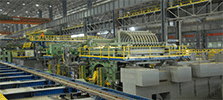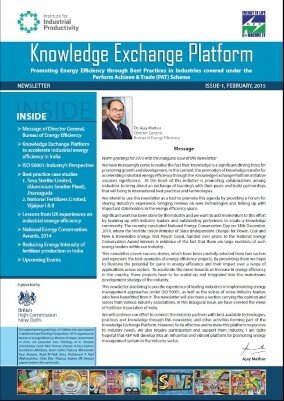17 August, 2016
at Department of Environment, Bangladesh Ministry of Environment and Forests, Poribesh Bhaban, E/16, Agargaon, Sher-e-Bangla Nagar, Dhaka-1207, Bangladesh
Institute for Industrial Productivity India (IIPI) in partnership with Bangladesh Department of Environment is supporting the implementation of a project to ‘Promote resource efficiency in key industry sectors of Bangladesh’ that aims to promote resource conservation in the brick making by promoting innovative policies, technologies, best practices and through knowledge sharing.
Brick Sector is important for Bangladesh’s growth and development and contributes to 1% of the country’s GDP and employs more than 1 million people. The Bangladesh brick industry has been growing at a fast pace and is the fifth largest producer of brick globally. The growth in the brick industry is driven by growing urban population and rapid infrastructure growth. The operations of the brick sector, however, is highly unsustainable. The current practice of brick making is characterized by conventional technologies with low energy efficiency, high emissions and dominance of single raw material (clay) and product (solid clay brick). Bangladesh currently produces around 17 billion bricks per year, consuming around 45 million tonnes of fertile soil. This is equivalent to around 2,600 hectares of agricultural land. At this rate, the country is fast moving towards severe food shortages in the foreseeable future. Apart from using soil, brick kilns burn nearly 3.5 million tons of coal and 1.9 million tons of wood annually contributing significantly to air pollution.
There are innovative technological choices and policy measures that can address the issues currently being faced by the Bangladesh brick industry. Fly ash brick technology is one such option. A new innovative product called FAL-G (fly ash-lime-gypsum) brick offers many advantages over conventional brick making. It has the potential to completely eliminate carbon emissions and top soil as it uses fly ash as raw material instead of top soil and does not require any firing-thus completely eliminating fossil fuel use. Gainful utilization of fly ash becomes important in the current context of Bangladesh as the Government is planning for large coal based thermal power plants to meet the growing energy demand in the country. Once these power plants become fully operational, huge amounts of fly ash will be produced as a by-product. This can cause severe air, water and soil pollution, disrupt ecological cycles and can set off environmental hazards. Putting fly ash to productive use in brick manufacture thus reduces water, air, and soil pollution. Another important aspect of the FaL-G technology is that plants using it can operate throughout the year, unlike the traditional coal-fired brick kilns which work for about six months. This implies that the workforce is employed for the whole year and does not have to search for other ways to earn a living during the monsoon season when coal-fired brick kilns close down. By not using any fossil fuel, the FaL-G brick plants also provide a cleaner and healthier working environment for workers and their families. Fly Ash bricks are being promoted effectively as an alternative to burnt clay bricks in India and now over 18,000 FaL-G brick plants are in operation in India. Fly ash bricks are gaining popularity amongst builders and engineers because of its high strength. Additionally, it reduces plastering cost and brings down the consumption of cement mortar by 60 per cent as these bricks are available in several load-bearing grades. The high compressive strength of FAL-G bricks also eliminates breakages/wastages during transport and handling.
Under the project on the brick sector, an assessment was carried out to review the viability of the FaL-G technology in Bangladesh (with the help of inventors of the technology), in partnership with Department of Environment and Bangladesh Brick Manufacturers and Owners Association- BBMOA, through series of roundtable discussions focusing specifically on technical, and financial aspect of the technology; exposure visits to the actual sites where the FaL-G plants are in operation to understand the advantages and market related aspects from the brick industry entrepreneurs and end users of FaL-G bricks/ blocks and interaction with the policy makers in India to understand the advantages of the technology and also learn the opportunities and challenges faced by them in introducing the new technology and how they were overcome.
The first phase of the project culminated with a stakeholder consultative workshop on 25th February, 2016, to bring together all the concerned stakeholders on a common platform to discuss the possible road map for introducing and scaling up the FaL-G technology in Bangladesh under the Chairmanship of Mr Md. Raisul Alam Mondal, Director General, Department of Environment, Ministry of Environment and Forests. A strong recommendation that emerged from the workshop was to carry out the ‘Technology Demonstration’ in Bangladesh, with a view to;
1. To have better demonstration impact and to reach out to wider stakeholders, it is important to have the demo unit close to Dhaka.
2. The ‘Demonstration Unit’ should not just show the range of products (bricks, blocks & concrete) and their quality/ strength, but also demonstrate its application in building construction and other infrastructure projects like road construction, pavements etc. on a pilot basis. This would help in creating wider awareness and in building confidence among (i) brick entrepreneurs about viability of the technology with locally available resources and raw material, and (ii) in construction companies and brick consumers about the cost, strength and quality etc.
3. The Thermal Power plants to ensure sustained supply of fly ash to the ‘Demonstration unit’. The ‘Demonstration Project’ should work closely with brick association (BBOMA), policy makers, construction companies, and certification agencies including public works department.
In order to ensure that all stakeholder groups were involved and had complete ownership over the demonstration process, the Bangladesh Department of Environment (DoE), Ministry of Environment and Forests convened a stakeholder consultation meeting on behalf of the project on 17th August, 20016. The meeting was Chaired by Mr. Q.S.I. Hasmi, Additional Director General, Department of Environment, Ministry of Environment and Forests and Moderated by Dr. Sultan Ahmed, Director (NRM & Research), Department of Environment. The meeting was also attended by all the major stakeholder groups, which included the Bangladesh Brick Manufacturers and Owners Association (BBMOA), Barapukuria Power Plant, Bangladesh Standards and Testing Institution (BSTI), Housing and Building Research Institute (HBRI) and Real Estate and Housing Association of Bangladesh (REHAB).
 Meeting under the Chairmanship of Mr. Q.S.I. Hasmi, Additional Director General, Department of Environment and Moderated by Dr. Sultan Ahmed, Director (NRM & Research), Department of Environment, Ministry of Environment and Forests
Meeting under the Chairmanship of Mr. Q.S.I. Hasmi, Additional Director General, Department of Environment and Moderated by Dr. Sultan Ahmed, Director (NRM & Research), Department of Environment, Ministry of Environment and Forests
The key action points agreed with the participants in the meeting were as follows:
1. Project Coordination: Department of Environment, Ministry of Environment and Forests, will act as the overall coordinating agency with all the concerned government agencies/ Ministries in Bangladesh for implementation of the demo project.
2. Policy/ Regulatory Reform: Department of Environment will also carry out two policy amendments viz. 1. Inclusion of fly ash in Bangladesh Environment Conservation Policy; and 2. Inclusion of Fly ash Bricks in existing Brick gazette (Brick Manufacturing and Kiln Set up (Control) Act, 2013) that will help in promotion of fly ash brick technology. DoE also agreed to initiate consultation process with the brick industry, on the provision to modify the existing provision of production of 50 % hollow brick in the existing Brick Gazette, to include non-fired /fly ash bricks.
3. Establishment of Supply Chain for fly ash: Barapukuria Power Plant is located near Dudhipur, Dinajpur, Bangladesh agreed to provide 12 tonnes of fly ash that would be needed for producing bricks from the demo plant provided DOE sent a request letter to them requesting for fly ash. DOE has agreed to send a letter to Barapukuria Power Plant in this regard.
4. Fly Ash Brick Standards and testing protocol: BSTI will work with the project team during the demonstration phase, and carry out the testing of the brick produced from the demo plant for its strength and quality. This is needed as the quality parameters may vary depending on the quality, nature and composition of the raw material available in Bangladesh. In order to develop the fly ash brick standard and testing protocol, BSTI will review the fly ash brick standards developed by ‘Bureau of Indian Standards (BIS) and explore the possibility of adopting them in Bangladesh with relevant modifications.
5. Technical Backstopping during demo and scale up phase: HBRI will act as the knowledge partner and repository of all technical information pertaining to the FaL-G technology. The project team will provide a technical manual to HBRI in this regard. HBRI will also work with the inventors and technical team of the project to improvise the technology as per local context, particularly in terms of enhancing the strength and quality of the brick with locally available raw material in a manner that it does not increase the cost and time of brick production.
6. Training and Capacity Building: HBRI will partner with the project in providing on the site training to master masons and workers during the demo project and then use these master trainers to train other mason and brick kiln workers through their network of institutions in Bangladesh.
7. Demand Generation/ Market development: PWD will use the brick produced from the demo plant in one of their construction project to demonstrate the advantages of fly ash bricks over clay bricks and also for creating confidence among the builders and consumers regarding the quality and strength of the brick. They will also explore the possibility of using the FaL-G bricks produced from demo plant in the construction of road in front of DoE office. Besides PWD, REHAB will also use its members to create awareness among construction companies on the commercial and technical advantages of of FaL-G bricks/ blocks over clay bricks.
8. Site of Demo Plant: In the meeting three possible sites and anchor institutions were identified for piloting the FaL-G plant. The first option is setting up the demo plant at the campus of HBRI and using the brick produced in the plant for construction of a structure at the premises of Bangladesh Planning Commission. The advantage of doing it at HBRI is that being in Dhaka, the demo plant can have a better demonstration impact by being accessible to policy makers, construction companies, REHAB members etc. which will provide better chances for policy influencing and creation of market demand. The other option is setting up the demo plant at a brick kiln site offered by member of BBMOA. Demo at this site will be useful because it will provide an opportunity to test the plant in actual site condition, which will make it easier to convince the brick industry about its viability. The third option is that PWD pilots the plant and uses the brick in one of their construction site. But this option may not provide opportunity for exposure to brick sector. DoE mentioned that they will review the comparative advantages of the three option and decide on the site that offers best possibility for creating the demonstration impact.


